Table of Contents
Block Diagram Reduction Technique
Block Diagram Reduction Technique: A block diagram is a diagrammatic representation of the cause-and-effect relationship between the input and output of a physical system represented by the flow of signals. Block Diagram Reduction Technique gives the relationship that exists between various components of a system. The open-loop and the closed-loop systems can be represented by using the block diagram reduction technique.
Open-Loop and Closed-Loop Systems
A system that cannot change its output in accordance to the change in input is known as a open-loop system. Such an open-loop system can be represented by using a block diagram as shown in figure below.

A system that can change its output in accordance with change in input is known as a closed-loop system. This can be implemented by introducing a feedback path in a open-loop system and manipulating the input that is applied to the system. Such a closed-loop system can be represented by using a block diagram shown in figure below.
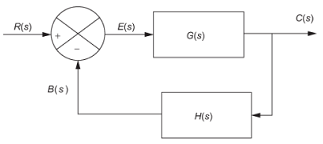
Block Diagram Reduction
Need for Block Diagram Reduction
In any complex real-time system, many individual sub-systems exist which can be represented by means of individual blocks. The individual blocks of each sub-system shown in figure below are combined to form the block diagram for the system. These individual blocks contain the transfer function of each sub-system.

After applying certain rules to the block diagram shown in above figure, the complex block diagram can be reduced to a simpler one as shown in figure below. Thus, from the reduced form of the block diagram, the transfer function of the complex system can be determined.

Block Diagram Algebra
Before knowing the rules in reducing the complex block diagram to a simple block diagram, it is necessary to know some terminologies related to the block diagram. Consider a simple block diagram as shown in figure below.
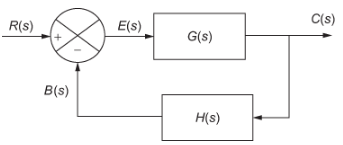
Block
The individual elements of a system can be represented by using blocks, which processes the input signal applied to it and produces an output. The blocks can either be in the forward path or in the feedback path. The blocks for the given block diagram are represented by dotted lines as shown in figure below.
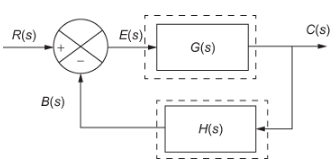
Input Signal
A solid line with an arrow at the end pointing towards any block/summing point in the block diagram representation of a system is known as an input signal. A schematic diagram representing one of the input signals is represented by dotted lines in figure below.
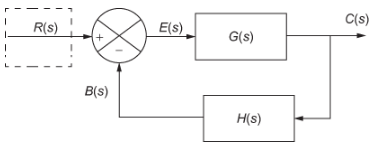
Forward Path
The flow of signal from the input to output represents the forward path. The representation of the forward path for the block diagram shown in Fig. 3.6 is represented by dotted lines in figure below.
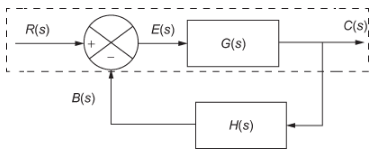
Feedback Path
The flow of signal from the output to input represents the feedback path. The representation of the feedback path for the block diagram shown in Fig. 3.6 is indicated by dotted lines shown in figure below.
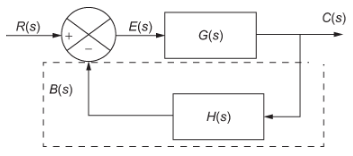
Feedback Signal
The signal in the feedback path is known as the feedback signal. For the block diagram, the feedback signal is denoted by B(s).
Error Signal
The signal obtained by the algebraic sum/difference of any two signals is known as the error signal. In the figure of block diagram, the error signal is represented as E(s), which is the algebraic difference of a source input signal and the feedback signal. The error signal is mathematically expressed as
E(s) = R(s) – B(s)
Summing Point
A block/an element at which two or more signals are either added or subtracted is known as the summing point. The diagram denoting the summing point for the block diagram given in Fig. 3.6 is represented by dotted lines shown in figure below.
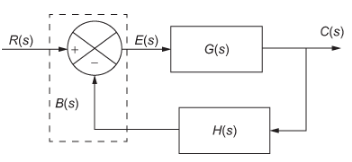
Output Signal
The signal that comes out from each block/summing point in any block diagram representing a system is known as the output signal. In the figure of block diagram, the output signals are C(s) and B(s).
Take-Off Point
The point at which a signal is applied to two or more blocks is known as the take-off point. The signal might either be an input signal or an output signal. The take-off point for the block diagram shown in Fig. 3.6 is represented by dotted lines shown in figure below. In this case, the output signal is taken as the regulated output and also given as the input to the block in the feedback path.
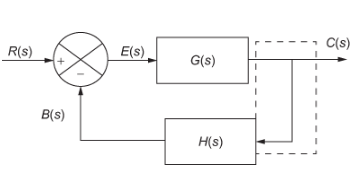
Rules for Block Diagram Reduction
Any complex block diagram representing a system can be reduced to a simple block diagram for determining the transfer function by applying certain rules. The rules that can be used in simplifying the given complex block diagram are as explained below. Proof for the rules is obtained by determining the output of the original block diagram and its equivalent block diagram.
1.Cascading the blocks in series
When there are two or more blocks in series without any take-off/summing point in between them, then the individual transfer function of each block is multiplied to form a single block. The original block diagram and its equivalent block diagram are shown table below.
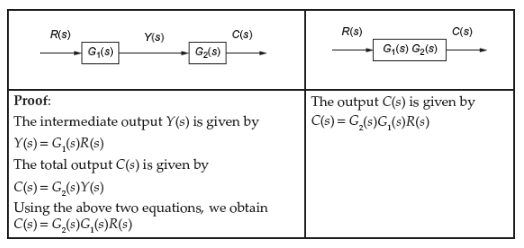
From the above table, it is clear that the output obtained after cascading the blocks in series is similar to the original block diagram output.
2. Cascading the blocks in parallel
When there are two or more blocks in parallel in the forward path, then the individual transfer function of each block is added to form a single block. The original block diagram and its equivalent block diagram are shown in table below.
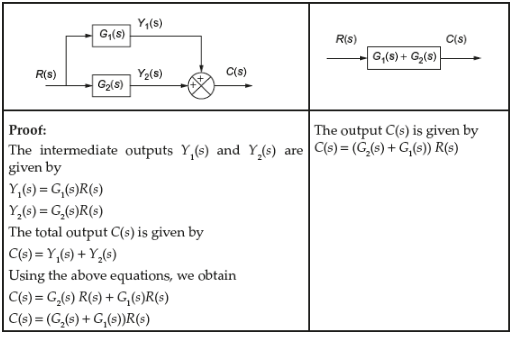
From the above table, it is clear that the output obtained after cascading the blocks in parallel in the forward path is similar to the original block diagram output.
3. Reduction of feedback loop
When there exists a feedback loop in a system, the feedback loop can be reduced to a single block. The feedback loop can either be negative or positive. The blocks representing the feedback loop and its equivalent block diagram are shown in table below.

From the above table, it is clear that the output obtained after reducing the feedback loop is similar to the original feedback loop output.
4. Moving the take-off point after/before a block
The take-off point that exists between the blocks can be moved either before the block or after the block.
After a block
The changes to be made in the block diagram in moving the take-off point after the block and original block diagram is shown in table below.
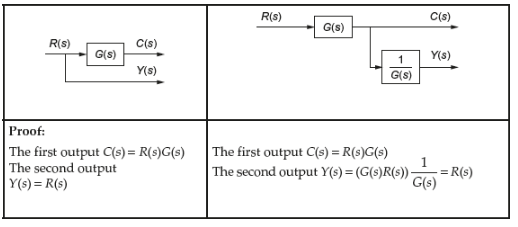
Before a block
The changes to be made in the block diagram in moving the take-off point before the block and original block diagram is shown in table below.
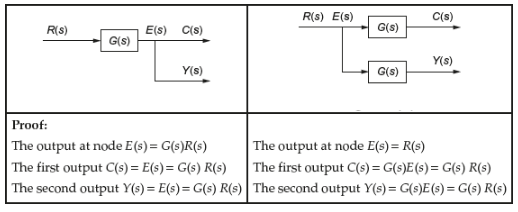
From the above proof, it is clear that the output obtained after shifting the take-off point before a block is similar to the original block diagram output.
5. Moving the summing point after/before a block
The summing point that adds/subtracts two or more signals can be moved either after or before a block.
After a block
The changes to be made in the block diagram in moving the summing point after the block and original block diagram is shown in table below.
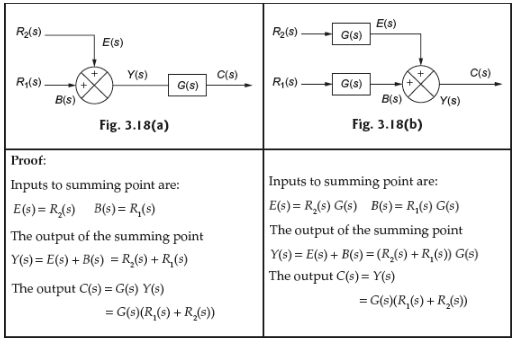
Before a block
The changes to be made in the block diagram in moving the summing point before the block and original block diagram is shown in table below.
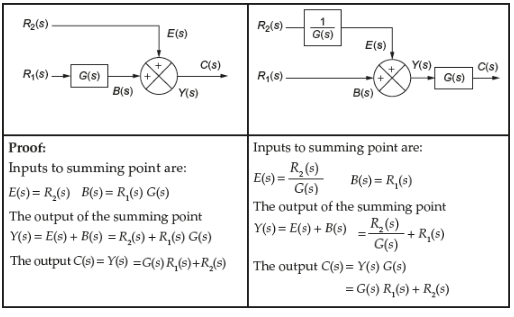
6. Splitting/joining a summing point:
The summing point that adds/subtracts two or more signals can be split into two summing points, or two summing points can be joined together to have a single summing point.
Splitting the summing points
A summing point that adds/subtracts three signals can be split into two summing points. The block diagram explaining the concept is shown in in table below.
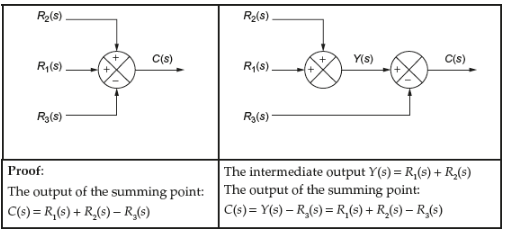
Joining the summing points
Two or more summing points present in the block diagram can be joined together to form a single summing point. The block diagram explaining the concept is shown in table below.
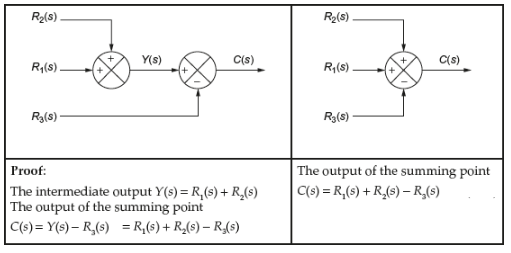
From the above proof, it is clear that the output obtained after joining the summing point is same as the output of the summing point without joining.
7. Moving a take-off point after/before a summing point:
The take-off point that exists in the block diagram can be moved after or before a summing point without changing the output of the system. The block diagram explaining the concept is shown in table below.
After summing point
The changes to be done in the block diagram in shifting the take-off point after a summing point is explained is shown in table below.
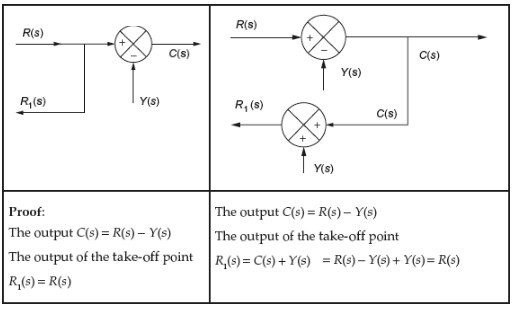
Before summing point
The changes to be done in the block diagram in shifting the take-off point before a summing point is explained is shown in table below.
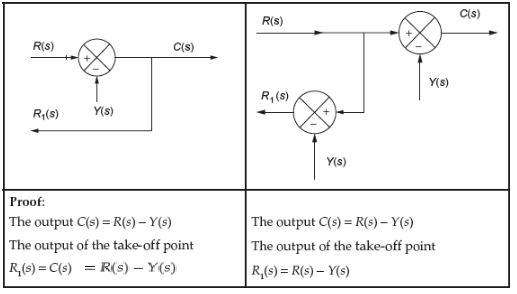
8. Exchanging two or more summing points:
Two or more summing points present in the block diagram can be interchanged without changing the output of the block diagram. The block diagram explaining the concept of exchanging the summing point is shown is shown in table below.
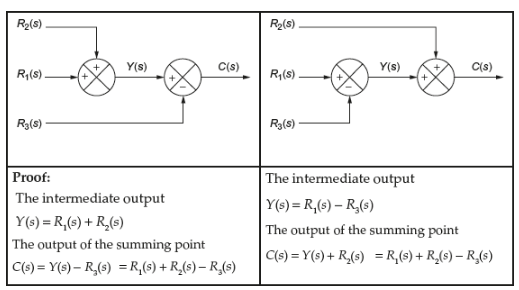
Block Diagram Reduction for Complex Systems
The flow chart for reducing the complex block diagram to a simplified block diagram is shown in figure below.
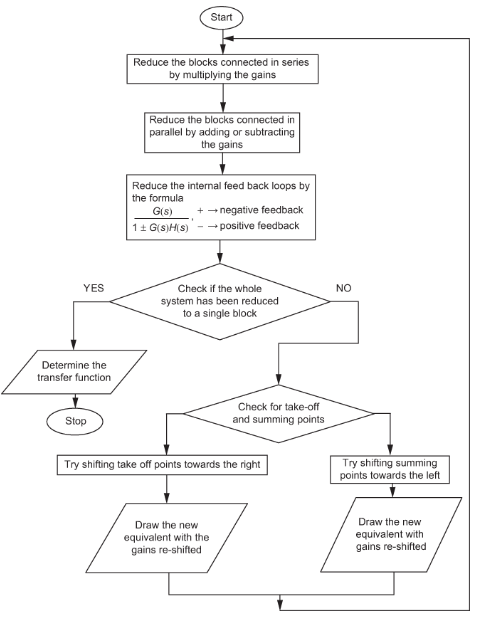
Advantages of Block Diagram Reduction Technique
The advantages of block diagram representation are:
- It facilitates easier representation of complex systems.
- Calculation of transfer function by block diagram reduction techniques is easy.
- Performance analysis of a complex system is simplified by determining its transfer function.
- It facilitates easier access of individual elements in a system that is represented by a block diagram.
- It facilitates visualization of operation of the whole system by the flow of signals.
Disadvantages of Block Reduction Technique
The disadvantages of block diagram representation are:
- It is difficult to determine the actual composition of individual elements in a system.
- Representation of a system using block diagram is not unique.
- The main source of signal flow cannot be represented definitely in a block diagram.


